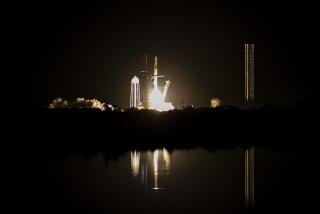Exxon Seen Making Major Acquisition
NEW YORK — Exxon Corp., which has trimmed staff and sold non-oil businesses, has more than $2 billion in cash and analysts speculate it may expand its oil holdings in a period of depressed oil prices.
With $2.04 billion in cash and a long-term debt to capital ratio of 13%, analysts say Exxon could make a major acquisition. “They could leverage-up very considerably without affecting their triple-A debt rating,” said analyst George Friesen of Dean Witter Reynolds Inc.
Exxon is rumored to be looking at Tenneco Inc.’s oil and gas properties, put up for sale this year.
Imperial Oil Ltd., Exxon’s 70%-owned Canadian unit, is also seen as a suitor for Texaco Inc.’s 78% stake in Texaco Canada Inc.
Exxon will not comment on the rumors. “It is our corporate policy not to comment on rumors of acquisitions and mergers,” an Exxon spokeswoman said.
Exxon has been criticized for not making a major acquisition during the big oil mergers of the 1980s and for spending too little on oil and gas properties. But the company has said it reviewed most properties that were offered for sale and found many of them too expensive.
Since 1984, Exxon has spent $3.3 billion on 830 million oil equivalent barrels of reserves--an average of $4 a barrel.
The company’s reserves stand at about 13.9 billion oil equivalent barrels. Its record of reserve replacement--replacing the oil and gas it consumes--is second only to Royal Dutch/Shell Group over the past three years, said analyst Fred Leuffer of C. J. Lawrence Morgan Grenfell Inc.
Exxon says it replaced 109% of the reserves it has consumed over the past five years. And last year it spent $1.8 billion on the acquisition of Celeron Oil & Gas Co. in the United States and Delhi Petroleum Proprietary Ltd. in Australia.
Despite depressed world oil prices, Exxon has built a solid base of cash through asset sales and reorganization.
After the oil price collapse of 1986, Exxon sold its electric motor business, New York headquarters and nuclear power operations, focusing on its core oil and gas and chemicals business.
At the same time, it reorganized its operations and thinned the ranks of management, reducing 7,000 employees in the past two years. It now has 100,000 employees worldwide, compared to 182,000 in the early 1980s.
“The company is super-efficient,” said Sanford Margoshes at Shearson Lehman Hutton Inc. “One of its characteristics is its extreme cost-consciousness.”
Although earnings dipped 9.7% in 1987 to $4.8 billion, the company said it gained $375 million from the reorganization--more than the $319-million charge it took for the program in 1986. Earnings are also returning this year as gains in chemicals, refining and marketing are making up for the shortfall in exploration and production.
Six-month earnings rose to $2.65 billion from $2.2 billion a year earlier. Excluding a special gain in the prior year, second-quarter 1988 earnings were up 30%.
The pace in earnings should continue for the rest of the year, with analysts looking for 1988 net of about $3.60 a share, compared to $2.65 in 1987.
Despite depressed oil prices, analysts said the company has offered a stable return to investors in the range of 30% a year, including reinvested dividends, over the past five years.
Although Royal Dutch/Shell Group and British Petroleum Co. PLC have both had better returns, analysts say the foreign oil companies have benefited from currency gains because of the lower dollar.
Exxon’s returns have been aided by a $10-billion stock repurchase program over the past five years and dividend rises each year since 1981. Trading at 46.375 a share, the company has a market value of more than $63 billion.
More to Read
Inside the business of entertainment
The Wide Shot brings you news, analysis and insights on everything from streaming wars to production — and what it all means for the future.
You may occasionally receive promotional content from the Los Angeles Times.










